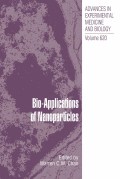
In this edited book, we highlight the central players in the Bionanotechnology field, which are the nanostructures and biomolecules. The book starts by describing how nanostructures are synthesized and by describing the wide variety of nanostructures available for biological research and applications. Also shown are the techniques used to synthesize a wide variety of biological molecules. Next, there is a focus on the assembly of nanostructures with biological molecules, which could lead to the design of multi-functional nanosystems. In the following chapters, examples of the unique properties of nanostructures are provided along with the current applications of these nanostructures in biology and medicine. Some applications include the use of gold nanoparticles in diagnostic applications, quantum dots and silica nanoparticles for imaging, and liposomes for drug delivery. In the final chapters of the book, the toxicity ofnanostructures are described. INDICE: Synthetic strategies to size and shape controlled Nanocrystals andNanocrystal Heterostructures. Current approaches for engineering proteins with diverse biological properties. Past, present, and future of Gold Nanoparticles. Multi-Functional Gold Nanoparticles for drug delivery. Quantum dots for cancer Molecular Imaging. Carbon Nanostructures as a new high-performance platform for MR Molecular Imaging. Magnetic Nanoparticle Assisted Molecular MR Imaging. Patterning Metallic Nanoparticles by DNA Scaffolds. Liposomes in Biology and Medicine. Fluorescent Nanoparticles for bacteria and DNA detection. Dendrimer 101. Quantum dots and other Fluorescent Nanoparticles Quo Vadis in the cell?- Toxicity studies of fullerenes and derivatives. Toxicity studies of Carbon Nanotubes.
- ISBN: 978-0-387-76712-3
- Editorial: Springer
- Encuadernacion: Cartoné
- Páginas: 207
- Fecha Publicación: 01/02/2008
- Nº Volúmenes: 1
- Idioma: Inglés
